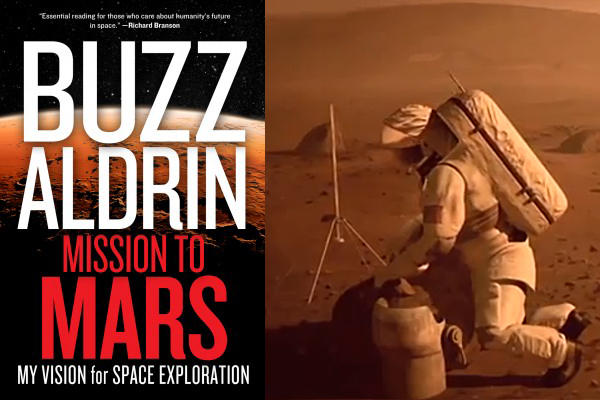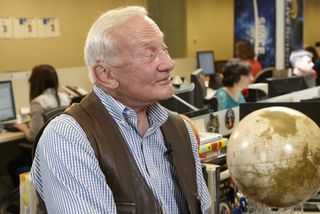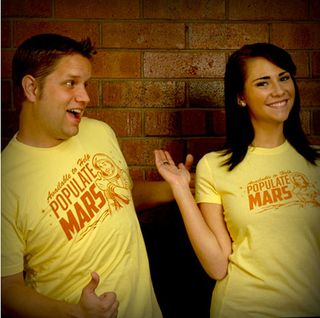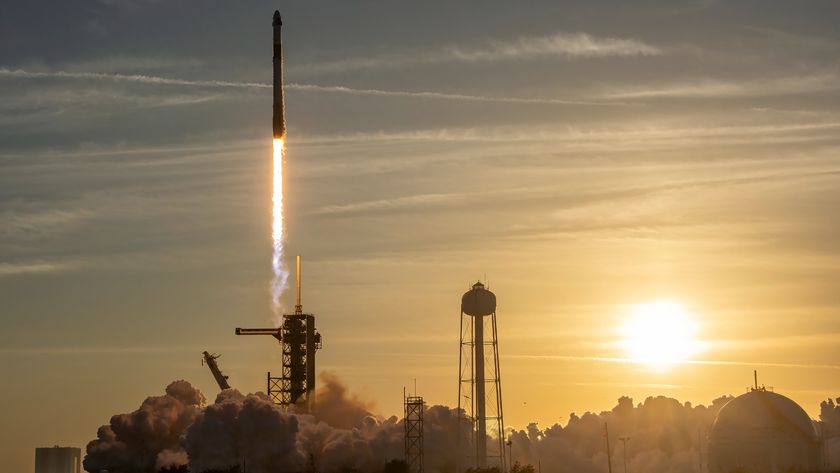Buzz Aldrin Says Humanity's Future Is On Mars (Exclusive Video)

NEW YORK — The moon is not enough for Buzz Aldrin, the second man ever to walk on the lunar surface. If humanity is to truly realize its space travel potential, there is only one place it will find it: Mars.
Aldrin's new book "Mission to Mars: My Vision for Space Exploration" lands in bookstores today (May 7) to chart out a course that could put astronauts on the surface of Mars by 2035. The famed Apollo 11 moonwalker met with SPACE.com this week to discuss his "unified space vision" for Mars exploration.
"The mission really is establishing permanence on another planet in the solar system,"Aldrin told SPACE.com in a video interview Monday (May 6).

Aldrin's plan calls for NASA and the United States to focus technology development efforts for a manned Mars mission while still remaining a global leader in human spaceflight. The plan does not completely forgo a return of astronauts to the moon, but does state that NASA should not send astronauts there. Instead, his plan states, other countries like China, India and Russia can focus on exploration of the lunar surface while NASA fine-tunes the tech needed for Mars trips from stable Lagrange points near the moon. [The Boldest Mars Missions So Far]
Aldrin penned "Mission to Mars" with veteran space reporter Leonard David, a former SPACE.com writer and frequent contributor, to lay out a plan that could carry humanity to the Red Planet on an accessible timescale. The book is Aldrin's fourth, and is published by National Geographic Books.
Under Aldrin's plan, an early expeditionary trip to Mars' largest moon Phobos by 2033 could test the vital habitation modules needed for Red Planet missions, as well as make use of telepresence to remotely control rovers on the planet's surface, Aldrin said.

"It turns out that just a good test of the interplanetary hab module, I think No. 3 or No. 4 … should get on to Mars in preparation for transit to Phobos, as a control center," he added.
Get the Space.com Newsletter
Breaking space news, the latest updates on rocket launches, skywatching events and more!
Deep-space cruisers, Mars cyclers based on Aldrin's research into cyclic spacecraft trajectories, would serve as the primary ferries to and from the Red Planet under the astronaut's vision.
The ultimate goal, Aldrin said, is a permanent Mars base that would truly make humanity a two-planet species. He said he would love to see a presidential commitment to continuous manned Mars exploration by 2019 — the 50th anniversary of the historic Apollo 11 moon landing by himself and Neil Armstrong.
"Within two decades, to have Americans pioneering the permanence on another planet in this solar system — can you imagine Earth history?" Buzz Aldrin said. "The big movement from Earth to another planet … it's a big deal."
Aldrin isn't alone in his quest to push humanity toward the Red Planet. This week, NASA scientists and researchers from around the world are discussing the major challenges in sending humans to Mars at the Humans 2 Mars Summit in Washington, D.C.
On Monday, NASA chief Charles Bolden told those attending the science conference that sending astronauts to Mars was "man's destiny."
"Interest in sending humans to Mars I think has never been higher," Bolden said.
Meanwhile, at least two private groups — the Inspiration Mars Foundation and Mars One — are working on very different visions to send humans to the Red Planet. Inspiration Mars is an audacious project led by American entrepreneur Dennis Tito, the world's first space tourist, to send two astronauts (preferably a married couple) on a flyby mission around Mars in 2018.

The Mars One project is led by Bas Lansdorp of the Netherlands, and seeks to establish a private Mars colony by 2023. To do that, pioneering astronauts would have to sign on for a one-way trip to the Red Planet.
As of today, about 78,000 people have applied for the Mars One colony project. Lansdorp and his team hope to ultimately receive 500,000 applicants before beginning the long search for the first four-person Mars One crew.
Email Tariq Malik at tmalik@space.com or follow him @tariqjmalik and Google+. Follow us @Spacedotcom, Facebook and Google+. Original article on SPACE.com.
Join our Space Forums to keep talking space on the latest missions, night sky and more! And if you have a news tip, correction or comment, let us know at: community@space.com.

Tariq is the Editor-in-Chief of Space.com and joined the team in 2001, first as an intern and staff writer, and later as an editor. He covers human spaceflight, exploration and space science, as well as skywatching and entertainment. He became Space.com's Managing Editor in 2009 and Editor-in-Chief in 2019. Before joining Space.com, Tariq was a staff reporter for The Los Angeles Times covering education and city beats in La Habra, Fullerton and Huntington Beach. In October 2022, Tariq received the Harry Kolcum Award for excellence in space reporting from the National Space Club Florida Committee. He is also an Eagle Scout (yes, he has the Space Exploration merit badge) and went to Space Camp four times as a kid and a fifth time as an adult. He has journalism degrees from the University of Southern California and New York University. You can find Tariq at Space.com and as the co-host to the This Week In Space podcast with space historian Rod Pyle on the TWiT network. To see his latest project, you can follow Tariq on Twitter @tariqjmalik.









